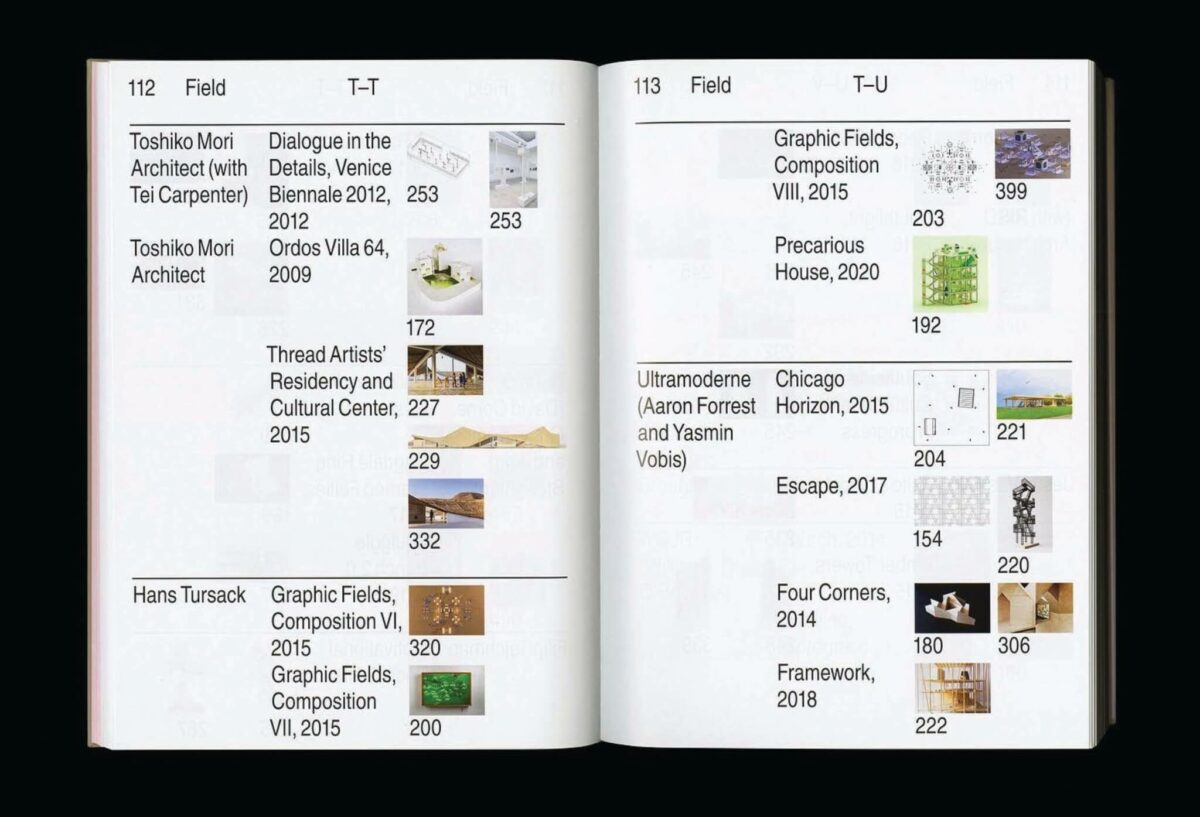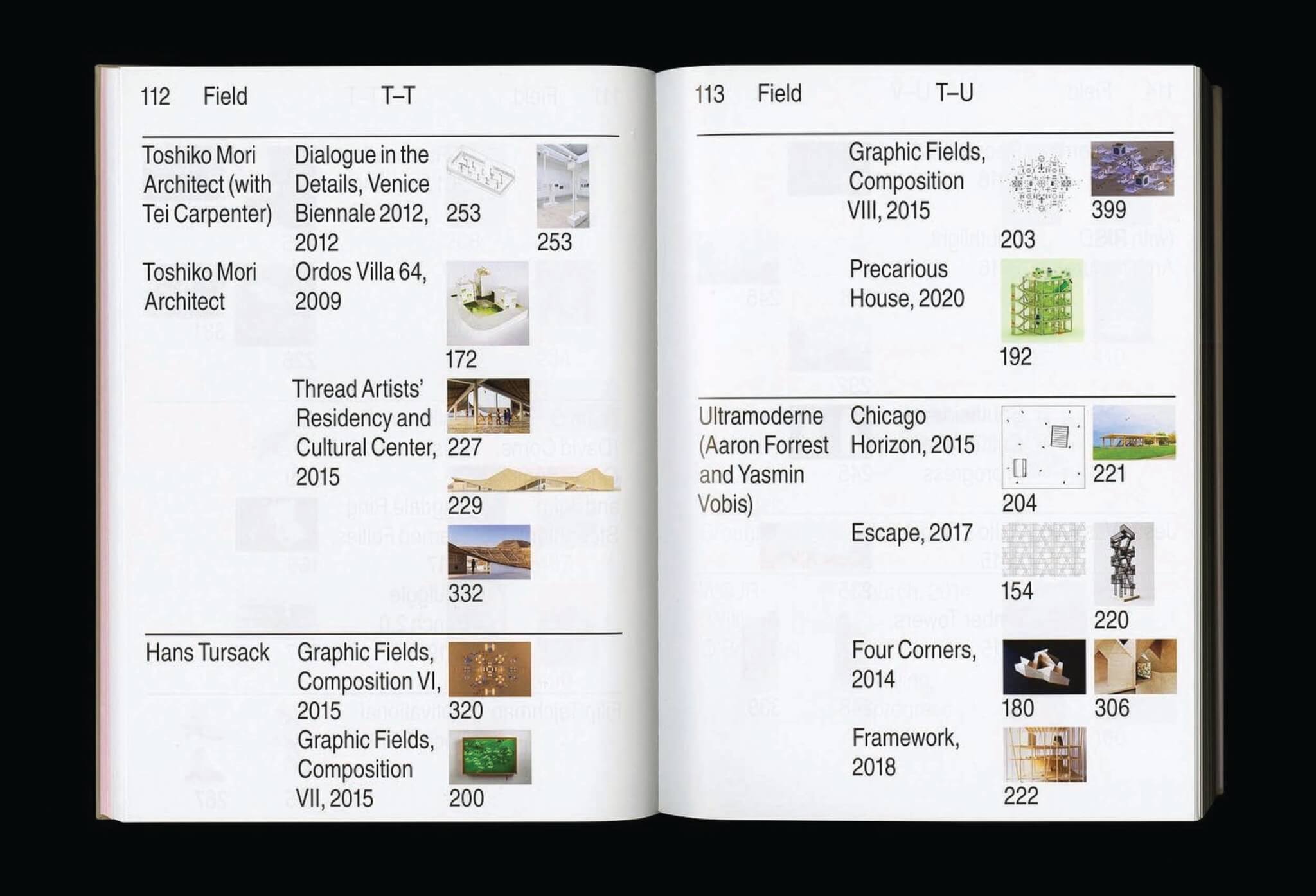

An interior spread of the table of contents from Inscriptions: Architecture Before Speech, designed by Studio Lin (Courtesy Harvard GSD/Harvard University Press)
Inscriptions: Architecture Before Speech
Edited by K. Michael Hays and Andrew Holder | Harvard University Graduate School of Design, Harvard University Press | $60
Inscriptions: Architecture Before Speech is a 624-page doorstopper reminiscent of the shelf-busting tomes published in the anni mirabiles of the late 1990s. It is filled with excellent work, much of it exhibited in a show staged at the Harvard Graduate School of Design’s Druker Gallery in 2018, also called Inscriptions. Both efforts attempt to extract a theory of contemporary architecture from a constellation of 112 practices—some young, others more well-known—that fill faculty rosters in architectural schools throughout the world. Many of the designers and practices come from the GSD’s ranks or have studied there. However, Inscriptions does not feel burdened by a sense of disproportionate representation. In looking at the 750 images chosen by K. Michael Hays and Andrew Holder for Inscriptions, what emerges is a snapshot of a moment in contemporary practice invested (as usual) in forms, materials, and tectonics. This is no surprise, of course, and even an architecturally interested reader with no prior knowledge of the book or appetite for its heady arguments will recognize the work by the featured practices. Viewers will likely appreciate seeing these projects in a single bound volume, fully outside the more familiar formats of social media. Gathered together, there is a hint of cohesiveness—a flash of understanding that, yes, these folks are all up to something interesting.
Blink, however, and you may miss the occasional nods to urbanism, landscape, or infrastructure. The same goes for the handful of moments that address current events (primarily in essay contributions by Lucia Allais and Sylvia Lavin). History, or rather its imperfect, formalist eidolon—breathed into life by Rudolf Wittkower and Colin Rowe and kept alive today by Hays—remains at the forefront in Inscriptions. Hays and Holder argue for a persistence of forms (“Originals”) that predate texts and thereby inscribe themselves in architectural culture. Readers may find it strange that a term that refers to the act of writing is used to refer to something that existed before speech. Yet in his introductory “Prelude,” Holder disposes of this conundrum rather quickly. He is clear in his insistence that “Inscription” is not about writing, but about creating a media-friendly array of objects with banal titles like “slack collections,” “scatters,” and “stacks.” “Architects pitch design against—or rather inscribe it onto—the emptiness of what we would call an original […] such that the original persists as a regulating substrate even while it is overwritten by the architectural activity reforming its surface,” Holder continues, in a passage reminiscent of Franz Kafka’s “In the Penal Colony.” In that story, a visitor travels to a prison to get a firsthand glimpse of the “Harrow,” a machine that inscribes and re inscribes a sentence for a crime on a prisoner’s flesh.
I also thought of Fredric Jameson’s 1975 book, The Prison-House of Language. As a reviewer, I feel sheepish about conjuring Jameson, yet his presence lurks within the heady conceptualizing in Inscriptions. The Prison-House of Language is especially relevant: In it, Jameson remarked how “philosophic language feels its way gropingly along the walls of its own conceptual prison, describing it from the inside as though it were only one of the possible worlds of which the others are nonetheless inconceivable.” Something similar is happening in Inscriptions, and it becomes especially evident when noticing the book’s design. In each of the chapters dedicated to an inscription, project images are printed as monochrome plates, a design decision that leaves them bereft of any vitality. (Color arrives on the glossy signatures, reserved for the table of contents and interludes.) Within the pages of Inscriptions, the field of contemporary architecture is flattened, whether due to Studio Lin’s now-familiar brand of monograph normcore, or conformed to Hays and Holder’s curatorial vision pinned to the page.
Reading through Inscriptions is like listening to a piece of ambient music or binge-watching a streaming show. It is like the steady blur of white noise, a kind of background that does not necessarily serve as a setting but is just there. Relentlessly so. And after a while all your eyes may recognize are fields of square black-and-white images interspersed among lengthy essays typeset in a vertically elongated sans serif typeface that seems to be made to be read quickly from top to bottom in a PDF format on a computer screen. The book captures today’s doomscroll aesthetic.
The debt to semiotic theory is clear enough that the diagram that organizes the book’s content comes from A. J. Greimas’s “semiotic square.” The square bears a passing resemblance to the Klein diagram made famous in Rosalind Krauss’s “Sculpture in the Expanded Field,” and yet it is supposed to operate more like a blank terrain, or even something like the “Approval Matrix” in New York Magazine. It is, in other words, a flat space, an idealized frame for idealized relations. It also puts readers in the unlikely position of having to make sense of the book on their own. It is all well to ask the reader to make conjectures and find patterns. However, when your only guide is a talismanic diagram that itself becomes an empty signifier, things can get a bit taxing. (It evokes Laurie Anderson’s quip from her song “Sharkey’s Night”: “Hey sport. You connect the dots. You pick up the pieces.”) Or, to use a term from astronomy, it is asterism: finding, in a vast field of objects and stars, connections and patterns that otherwise did not exist.
Throughout Inscriptions, the editors and contributors refer to Hays and Holder’s curatorial vision. What this vision is, however, remains a mystery, as it is alluded to in the most generic terms. “Curation,” Holder declares in the prelude, “is perhaps the ideal test bed for this ambition to align discourse with architecture’s artifacts.” And when it comes to the tricky issue of writing an exhibition catalogue, Holder admits that the book is not so much a tabula rasa as an opportunity to revisit and reimagine the meaning of “inscription” and its relation to architectural culture. And yet the contributing essays seem to operate as if the book were a more traditional exhibition catalogue. Stan Allen, for instance, observes that “Inscriptions maps […] the dilemma of the exhibition curator when practice itself has become a form of curation. For many younger architects, including some represented in this publication, design is reconceived as an operation of selecting, sorting, and editing.” These are largely generic statements about curation, the equivalent of telling readers, “Our curatorial strategy is that we have a curatorial strategy.” And if the intent is to portray design as curation, this too is unfortunate, because it reveals an all-too-overbearing curatorial strategy that focuses on similarity rather than originality.
There is a lot that is good in Inscriptions. The design work is generally excellent, and the reader is rewarded at the end of the book with a portfolio of projects with full descriptions and better images that do more work in describing the book’s ambitions. The essays too are often illuminating: Texts by Antoine Picon, Edward Eigen, Marrikka Trotter, and Lavin set a historiographic armature for Hays and Holder’s disciplinary ambitions. The temptation to mention Lavin’s essay in the same breath as Lucia Allais’s is because both are exceptional works that stand out in their analysis of the history and theory of screen culture in architectural education. Phillip Denny’s study of “the creaturely” is a bit puzzling only because his reliance on literary critic Sianne Ngai’s theory of the aesthetic category of “cute” is rendered into a purely visual category without acknowledging the importance of “larger social arrangements,” in Ngai’s words. The book ends with an intense postlude by K. Michael Hays that reconfigures semiotic theory with the goal of “allowing us to pass from identity politics to a political economy of the Thing” in a “theoretically infinite series of possible encounters.”
Inscription’s contents will no doubt be pored over in studios and seminars in the years to come. But any intellectual gains will be hard-won, as the opacity of the framework threatens to obscure the work of the 112 practices whose images are lodged within.
Enrique Ramirez is a writer and historian of art and architecture. He teaches at the University of Michigan’s Taubman College of Architecture and Urban Planning.